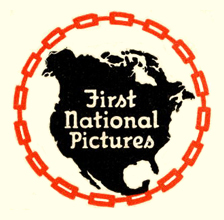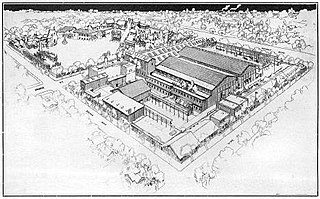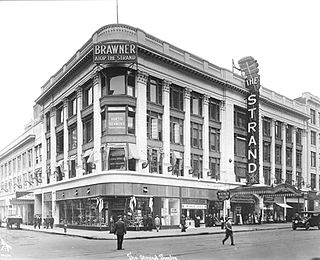
First National Pictures was an American motion picture production and distribution company. It was founded in 1917 as First National Exhibitors' Circuit, Inc., an association of independent theatre owners in the United States, and became the country's largest theater chain. Expanding from exhibiting movies to distributing them, the company reincorporated in 1919 as Associated First National Theatres, Inc., and Associated First National Pictures, Inc. In 1924 it expanded to become a motion picture production company as First National Pictures, Inc., and became an important studio in the film industry. In September 1928, control of First National passed to Warner Bros., into which it was completely absorbed on November 4, 1929. A number of Warner Bros. films were thereafter branded First National Pictures until July 1936, when First National Pictures, Inc., was dissolved.

Paramount Pictures Corporation is an American film and television production and distribution company and the main namesake subsidiary of Paramount Global. It is the fifth oldest film studio in the world, the second oldest film studio in the United States, and the sole member of the "Big Five" film studios still located in the city limits of Los Angeles.

Adolph Zukor was a Hungarian-American film producer best known as one of the three founders of Paramount Pictures. He produced one of America's first feature-length films, The Prisoner of Zenda, in 1913.

Universal Pictures is an American film production and distribution company owned by Comcast through the NBCUniversal Film and Entertainment division of NBCUniversal.
United States v. Paramount Pictures, Inc., 334 U.S. 131 (1948), was a landmark United States Supreme Court antitrust case that decided the fate of film studios owning their own theatres and holding exclusivity rights on which theatres would show their movies. It would also change the way Hollywood movies were produced, distributed, and exhibited. The Supreme Court affirmed in this case that the existing distribution scheme was in violation of United States antitrust law, which prohibits certain exclusive dealing arrangements. The decision created the Paramount Decree, a standard held by the United States Department of Justice that prevented film production companies from owning exhibition companies. The case is important both in U.S. antitrust law and film history. In the former, it remains a landmark decision in vertical integration cases; in the latter, it is responsible for putting an end to the old Hollywood studio system.

A movie palace is any of the large, elaborately decorated movie theaters built between the 1910s and the 1940s. The late 1920s saw the peak of the movie palace, with hundreds opened every year between 1925 and 1930. With the advent of television, movie attendance dropped, while the rising popularity of large multiplex chains signaled the obsolescence of single-screen theaters. Many movie palaces were razed or converted into multiple screen venues or performing arts centers, though some have undergone restoration and reopened to the public as historic buildings.

William Wadsworth Hodkinson, known more commonly as W. W. Hodkinson, was born in Independence, Kansas. Known as The Man Who Invented Hollywood, he opened one of the first movie theaters in Ogden, Utah in 1907 and within just a few years changed the way movies were produced, distributed, and exhibited. He became a leading West Coast film distributor in the early days of motion pictures and in 1912 he co-founded and became president of the first nationwide film distributor, Paramount Pictures Corporation. Hodkinson was also responsible for doodling the mountain that became the Paramount logo in 1914. After being driven out of Paramount, he established his own independent distribution company, the W. W. Hodkinson Corporation, in 1917, before selling it off in 1924. He left the motion picture business in 1929 to form Hodkinson Aviation Corporation, and later formed the Central American Aviation Corporation and Companía Nacional de Aviación in Guatemala.

The double feature was a motion picture industry phenomenon in which theatres would exhibit two films for the price of one, supplanting an earlier format in which one feature film and various short subject reels would be shown.
A film distributor is responsible for the marketing of a film. The distribution company may be the same with, or different from, the production company. Distribution deals are an important part of financing a film.

Famous Players-Lasky Corporation was an American motion picture and distribution company formed on June 28, 1916 from the merger of Adolph Zukor's Famous Players Film Company—originally formed by Zukor as Famous Players in Famous Plays—and the Jesse L. Lasky Feature Play Company.

The Mob is a 1951 American film noir crime-thriller produced by Columbia Pictures, directed by Robert Parrish, and starring Broderick Crawford. The screenplay, which was written by William Bowers, is based on the novel Waterfront by Ferguson Findley.
Walter Reade was the name of a father and son who had an extensive career in the United States motion picture industry.

The Chicago film industry is a central hub for motion picture production and exhibition that was established before Hollywood became the undisputed capital of film making. In the early 1900s, Chicago boasted the greatest number of production companies and filmmakers. Essanay Studios founded by George K. Spoor was one of the earliest successful studios to produce movies in Chicago, employing stars such as Charlie Chaplin and Gloria Swanson. Actor and co-founder of Essanay Studios, Broncho Billy Anderson gave birth to the western genre. Early film companies such as Essanay Studios produced multiple silent films every week and rented viewing equipment to showcase the latest cinematography to the public. This rental culture gave birth to the popularity of Nickelodeons up until the Great Depression. However, due to the high demand for motion pictures during this time, a black market for films and equipment developed. The Motion Picture Patents Company, established in 1909 as a conglomerate of the major studios, sought to eliminate all illegal use of patented film equipment. As a result, independent ventures entered the film scene. Independents drove the film industry to the west to avoid legal trouble with the trust of major film companies united under the Motion Picture Patents Company. The west offered fairer weather and scenery that better accommodated film making. Not until the 1980s and early 21st century has Chicago experienced a film production revival. Blockbusters, such as Blues Brothers, Sixteen Candles, and The Dark Knight, have rejuvenated the Chicago film scene.
Mitchel H. Mark a.k.a. Mitchell Mark a.k.a. Mitchell H. Mark was a pioneer of motion picture exhibition in the United States.

The Strand Theatre was an early movie palace located at 1579 Broadway, at the northwest corner of 47th Street and Broadway in Times Square, New York City. Opened in 1914, the theater was later known as the Mark Strand Theatre, the Warner Theatre, and the Cinerama Theatre. It closed as the RKO Warner Twin Theatre, and was demolished in 1987.
A film – also called a movie, motion picture, moving picture, or photoplay – is a work of visual art that simulates experiences and otherwise communicates ideas, stories, perceptions, feelings, beauty, or atmosphere through the use of moving images. These images are generally accompanied by sound and, more rarely, other sensory stimulations. The word "cinema", short for cinematography, is often used to refer to filmmaking and the film industry, and to the art form that is the result of it.

Abraham Joseph Balaban, known as A. J. Balaban or Abe Balaban, was an American showman whose particular influence on popular entertainment in the early 20th century led to enormous innovations in the American movie-going experience.
Showmen's Trade Review was a weekly trade magazine for exhibitors and distributors of motion pictures published by Charles E. "Chick" Lewis out of offices in New York City.

The Rialto Theatre was a movie palace in New York City located at 1481 Broadway, at the northwest corner of Seventh Avenue and 42nd Street, within the Theater District of Manhattan.

Life's Greatest Game is a 1924 silent Melodrama crime film produced by Emory Johnson Productions and distributed by FBO. This movie was one of the first films to take a realistic look at America's favorite pastime, baseball. The film is directed by Emory Johnson and is written by Emilie Johnson. It stars Johnnie Walker, Tom Santschi, Jane Thomas, David Kirby, and Gertrude Olmstead. The 1919 World Series Black Sox Scandal inspired the Emilie Johnson storyline and screenplay.


















